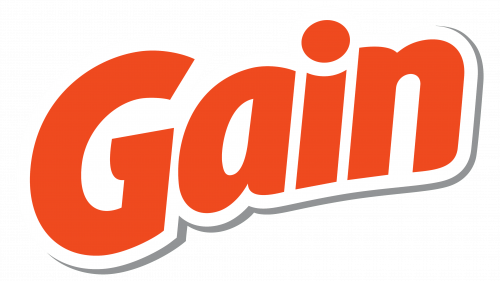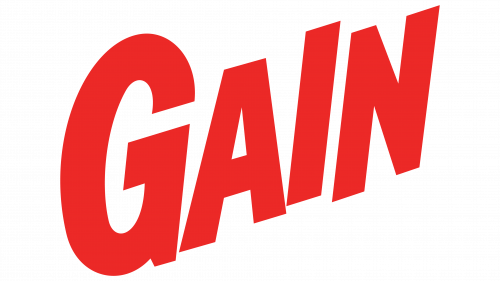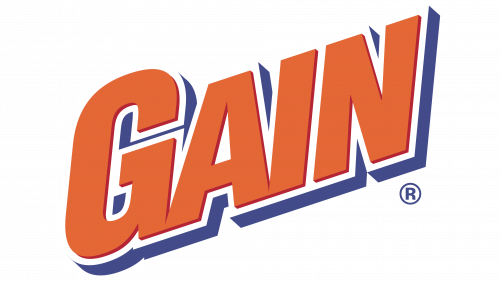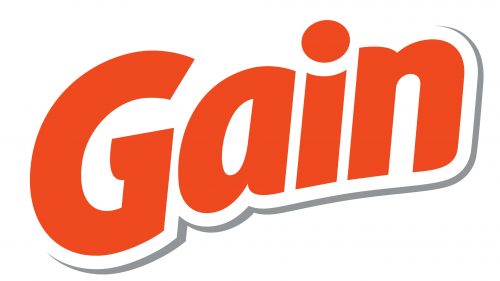The Gain logo symbolizes quality, setting the brand apart from competitors. The emblem is based on the association with soap bubbles that accompany the cleaning process, representing the crystal-clear cleanliness and freshness of the brand’s products.
Gain: Brand overview
When Procter & Gamble (P&G) released this new laundry detergent brand on the American market in 1969, the history of Gain officially began. Gain was created in response to consumers’ increasing need for more aromatic washing products. P&G wanted to make a laundry detergent that did more than just clean clothing; it left a lingering smell behind.
The brand was first marketed as a laundry detergent with a distinct, light aroma. This focus on scent was a novel strategy at a time when most rivals just addressed the products’ ability to clean.
The detergent began to gain traction with consumers in the 1970s. Its unique aroma was prominently promoted in print and television advertising, and the tagline “Gain gives you a fresh scent that lasts and lasts” became well-known among consumers.
The company expanded its product line during the 1980s. In 1981, it launched a liquid laundry detergent in response to the increasing consumer demand for laundry products in more convenient formats. This approach attracted new customers and solidified the brand’s market position.
The firm maintained its innovative streak in the 1990s, launching several new goods. Gain Ultra, a highly concentrated laundry detergent that offered better cleaning with less product, was introduced in 1995. This invention responded to consumers’ growing environmental concerns and desire to use fewer chemicals.
The brand experienced substantial growth in the 2000s. In 2004, it introduced a range of fabric softeners that provided a complete laundry care solution. These items were designed to improve the smell of clothes after washing.
In 2006, the brand expanded its product offering beyond laundry when it unveiled a range of air fresheners. This move allowed the company to enter a new market by leveraging its strong association with pleasant scents.
The decade of the 2010s saw increased innovation and product line expansion. In 2011, the company released a line of laundry scent enhancer beads called Fireworks. This product allowed customers to adjust the fragrance’s strength to their preferences.
In 2013, the brand introduced Flings, laundry pods incorporating stain remover, aroma booster, and detergent. This innovation met the increasing need for quick and efficient laundry solutions.
In 2015, the company introduced Botanicals, a line of laundry solutions influenced by natural scents, broadening its product offering. This range featured plant extracts, essential oil-infused pods, and liquid detergents. Botanicals offered fragrances such as “White Tea and Lavender” and “Orange Blossom and Vanilla,” catering to the growing demand for more natural products.
In 2016, the firm unveiled AromaBoost, a cutting-edge blend that enhanced the strength and longevity of the scent on clothing after washing. This technology was incorporated into several products, such as liquid detergents and pods. AromaBoost became a focal point of the brand’s marketing strategy, highlighting its distinct superiority in laundry scenting.
In 2017, the brand introduced Ultra Flings, an upgraded version of the laundry pods. With a more concentrated formula, these pods produced greater cleaning outcomes with less solution. Ultra Flings included AromaBoost technology to ensure a stronger and longer-lasting scent.
By launching a new range of fabric conditioners in 2018, the company increased its market share in the fabric care sector. These items were designed to soften fabrics and enhance scent, complementing the firm’s main laundry detergent line. The fabric conditioners came in various fragrances that matched the brand’s popular detergent scents.
The company introduced a brand-new range of antimicrobial products in 2020. This line includes fabric conditioners and laundry detergents that leave clothing smelling good and eliminate microorganisms. The introduction of this range responded to consumers’ growing health and hygiene concerns.
In 2021, the brand launched EcoBoost, a new product range. The growing need for more eco-friendly laundry solutions led to this innovative series. EcoBoost featured pods and liquid detergents packaged in 100% recyclable materials, including biodegradable ingredients. The popular scents were still present in the new collection.
In 2022, the enterprise increased its market share in the premium product sector by introducing the “Luxe Collection.” This collection offered more intricate and nuanced scents inspired by perfume compositions. Some of the scents in the “Luxe Collection” included “Black Orchid and Vanilla” and “White Jasmine and Amber.” The new line caters to customers willing to spend more on high-end laundry detergent scents and seek more sophisticated fragrances.
The firm improved its online presence in 2022 by releasing the “Scent Studio” mobile app. This app allowed users to mix and match different products to create custom aroma combinations. Users could receive personalized product recommendations and share their “scent recipes” with others.
In 2023, the company introduced “Smart Dose,” an innovative container for liquid laundry detergents. The integrated “Smart Dose” dispenser automatically measured the appropriate amount of detergent based on the laundry’s soil level and load size.
The enterprise has continued developing and adapting to consumers’ shifting demands and preferences, starting with a basic scented laundry detergent and expanding to a diverse range of luxury and eco-friendly products.
Meaning and History
What is Gain?
It is a brand of laundry detergent and fabric care products manufactured by Procter & Gamble. Known for its vibrant fragrances and effective cleaning power, it has taken a leading position in the laundry care market. The brand offers many products, including liquid and powder detergents, fabric softeners, dryer sheets, and fragrance enhancers. The brand has expanded beyond traditional laundry detergents, including dish soaps and other cleaning products with distinctive scents. The company appeals to consumers who place a high value on cleanliness and pleasant scents when doing laundry. Through colorful packaging and marketing, the brand has gained a loyal audience.
1969 – 2002
The first Gain logo appeared dynamic and ambitious. It featured red lettering that soared upward, emphasizing the growth and progress embedded in the brand’s name. The silhouette of the letters, slightly “dancing” and rising as if in water, conveyed the primary element in which the product operates. This approach highlighted the key ability of the product—removing even the toughest stains. The red hue of the lettering symbolized the powerful effectiveness of the detergent and the quick results delivered by the brand’s products.
2002 – 2005
The Gain logo underwent changes that made the lettering sleeker and more dimensional. The letters were given a white outline, with blue shading on the edges, symbolizing cleanliness and soap suds. This shade hints at the effect of Gain’s brilliant whiteness on fabrics.
The detailed imagery and three-dimensional elements emphasize the product’s high selectivity and effectiveness. The expanded functionality of the logo showcases the detergent’s ability to tackle a wide range of stains, reinforcing Gain’s position among premium cleaning products.
2005 – 2012
The 2005 Gain logo symbolizes the product’s three-step effectiveness. The lettering on the emblem takes on a triple-dimensional form, reflecting the process of cleaning items treated with the detergent. Gain products effectively remove stains, eliminate dirt, and infuse fabrics with a distinctive scent, addressing multiple laundry tasks simultaneously.
The logo design creates a sense of texture that the touch can feel. The viewer sees the symbol from a low angle, with the curved lower edges of the letters resembling a rainbow, highlighting the brand’s rise to the top. Gain has a strong position in the U.S. market and is regarded as one of the best stain-fighting products.
2012 – today
The new logo’s simplification by removing unnecessary three-dimensional elements has made it more modern and easier to perceive. This approach reflects the company’s desire to stay relevant and connected to consumers, demonstrating its readiness for change and improvement in line with new market demands.
The first thing that stands out is the rich orange-red color. This color choice carries deep meaning: it is associated with energy, determination, and passion. In the context of a brand that produces cleaning products, the vibrant color symbolizes activity and efficiency, emphasizing that the product quickly and effectively gets the job done. The orange-red color evokes a sense of warmth and coziness, which is important for a product intended for home use.
The bold and slightly slanted font gives the text a sense of dynamism and movement. This creates associations with progress and improvement and the company’s constant drive for innovation. The slanted font adds a sense of speed and determination to the brand, highlighting its active role in the market.
The visual simplicity of the logo symbolizes the accessibility and ease of use of the product, bringing the brand closer to the consumer. The subtle shading beneath the text adds a sense of depth and three-dimensionality.
The slight curve in the logo, with the first letter “G” positioned slightly lower than the others, emphasizes the cleaning process. This small tilt visually supports the idea that items retain their original appearance after using the products. It also adds an association with the care process, where each step is thoughtful and effective.
An interesting emblem element is its resemblance to a tag on new items. This design choice adds a symbolic connection between the logo and the idea of freshness and newness that the product brings. The subtle three-dimensional elements beneath the text enhance the association with a soap bar, directly linking the brand to cleanliness and freshness.





